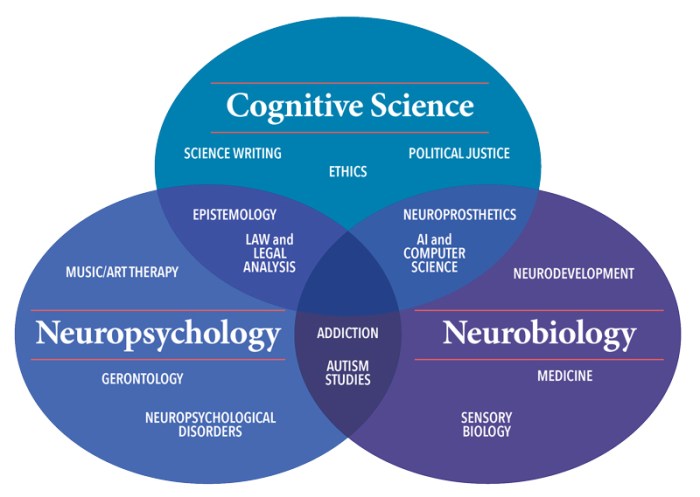
Embark on a journey into the world of philosophical concepts in psychology and neuroscience, where abstract ideas shape our understanding of the mind and behavior. Dive into the depths of how these concepts influence research and thought processes, creating a fascinating tapestry of interconnected disciplines.
Philosophical Concepts in Psychology and Neuroscience
Philosophical concepts play a crucial role in shaping the foundations of psychology and neuroscience, providing theoretical frameworks and guiding principles for understanding the mind and brain. These concepts influence the way researchers approach and interpret phenomena in these fields.
Key Philosophical Theories in Psychology and Neuroscience
- Rene Descartes’ Mind-Body Dualism: Descartes’ idea of the separation between the mind and body has influenced discussions on consciousness and identity in psychology and neuroscience.
- Determinism: Philosophical debates on determinism versus free will have implications for understanding behavior and decision-making processes in psychological and neuroscientific research.
Intersection of Philosophical Concepts with Research
- Mind-Body Dualism: The debate on the relationship between the mind and body underlies studies on consciousness, perception, and neural correlates of mental processes.
- Determinism and Free Will: Philosophical debates on determinism and free will intersect with research on decision-making, moral responsibility, and the nature of human agency in psychology and neuroscience.
Role of Ethics in Integrating Philosophical Concepts
- Ethical considerations are essential in the integration of philosophical concepts into psychological and neuroscientific studies to ensure the responsible conduct of research and the protection of human subjects.
- Ethical frameworks guide researchers in addressing complex questions related to consciousness, morality, and personal autonomy, influenced by philosophical perspectives on these topics.
Painting

Paintings have long been a powerful medium for expressing and exploring philosophical concepts. Artists use colors, symbols, and composition to convey abstract ideas that can be related to psychology and neuroscience.
Interpretation through Colors, Symbols, and Composition
Artists often utilize specific colors, symbols, and compositions to visually represent complex philosophical concepts. For example, the use of dark and light colors can symbolize the contrast between good and evil or the internal struggle of the human mind. Similarly, the arrangement of elements in a painting can reflect the chaos or harmony associated with different philosophical ideas.
Influence of Philosophical Movements
Philosophical movements such as existentialism, surrealism, and phenomenology have significantly influenced the creation of paintings. Existentialist themes of individuality and existence are often depicted through isolated figures or stark landscapes. Surrealist paintings, on the other hand, tap into the unconscious mind and challenge traditional perceptions of reality. Phenomenology, with its emphasis on subjective experience, inspires artists to explore the depths of human consciousness through their work.
Famous Paintings Embodying Philosophical Concepts
- The Persistence of Memory by Salvador Dali: This surrealist masterpiece challenges our perception of time and reality, reflecting the complexities of memory and consciousness.
- The Scream by Edvard Munch: The haunting imagery of this painting captures the existential angst and psychological turmoil experienced by the modern individual.
- The Son of Man by Rene Magritte: Through the use of symbols like the apple and bowler hat, Magritte explores the themes of identity, hidden truths, and perception.
Performing Arts
The performing arts, including theater and dance, offer a unique platform to explore complex psychological and neuroscientific themes. Through symbolism, body language, and dialogue, these art forms can effectively convey philosophical concepts, providing a deeper understanding of the human mind and behavior.
Theatrical Performances
Theatrical performances have the power to represent intricate psychological and neuroscientific themes through the use of symbolism, body language, and dialogue. Actors can embody different mental states and emotions, allowing audiences to witness the complexities of human experience on stage.
- The use of symbolism in plays can offer deeper insights into abstract philosophical ideas, allowing the audience to reflect on the underlying concepts.
- Body language plays a crucial role in conveying emotions and psychological states, providing a non-verbal representation of the inner workings of the mind.
- Dialogue in plays can explore philosophical concepts through thought-provoking conversations between characters, shedding light on different perspectives and ideologies.
Dance Performances
Dance performances, with their emphasis on movement and expression, can also serve as a powerful medium to express emotions and mental states linked to philosophical ideas. Through choreography and physicality, dancers can convey complex themes and concepts without words.
- Dance movements can symbolize abstract philosophical concepts, offering a visceral and visual representation of ideas that may be challenging to articulate verbally.
- Emotional expression through dance allows performers to tap into the depths of human experience, connecting with audiences on a profound level and evoking introspection.
Examples of Productions
Several theater and dance productions have delved into the intersection of philosophy, psychology, and neuroscience, offering thought-provoking explorations of the human experience.
- “The Glass Menagerie” by Tennessee Williams: This play delves into themes of memory, illusion, and the complexity of human relationships, offering a psychological exploration of the characters’ inner worlds.
- “Swan Lake” by Pyotr Ilyich Tchaikovsky: This iconic ballet combines music and dance to tell a story of love, betrayal, and transformation, exploring themes of identity and the power of art to express universal emotions.
Philosophy
Philosophical concepts play a crucial role in shaping the foundation of psychological and neuroscientific thought. These concepts provide the theoretical framework within which researchers in these fields operate, guiding their investigations and interpretations of human behavior and cognition.
Methodologies
- Philosophy, psychology, and neuroscience each have distinct methodologies for understanding human behavior and cognition.
- Philosophy relies on rational argumentation and conceptual analysis to explore fundamental questions about the mind and consciousness.
- Psychology employs empirical research methods, such as experiments and observational studies, to investigate mental processes and behavior.
- Neuroscience utilizes advanced technologies like brain imaging and electrophysiology to study the neural mechanisms underlying cognition and behavior.
Contributions of Philosophers
- Notable philosophers like René Descartes, John Locke, and Immanuel Kant have made significant contributions to the development of psychological and neuroscientific theories.
- Descartes proposed the concept of dualism, suggesting a separation between the mind and body, which influenced discussions on consciousness and identity.
- Locke’s ideas on empiricism and the tabula rasa (blank slate) theory have shaped modern psychology’s understanding of knowledge acquisition and human development.
- Kant’s work on transcendental idealism and the nature of perception has had a lasting impact on neuroscience’s exploration of sensory processing and cognition.
Debates on Consciousness
Philosophical debates on consciousness, perception, and identity have a profound influence on research in psychology and neuroscience. These debates raise fundamental questions about the nature of subjective experience, the relationship between mind and body, and the mechanisms underlying perception. Researchers draw on philosophical discussions to inform their experimental designs, theoretical frameworks, and interpretations of empirical data.
Photography
Photography is a powerful medium that allows artists to capture abstract philosophical concepts in visual form. Through the use of light, shadow, and perspective, photographers can evoke psychological and neuroscientific themes in their photographs. Additionally, photography plays a crucial role in documenting mental health issues and cognitive processes, shedding light on the complexities of the human mind.
Exploring Abstract Concepts
Photographers often use abstract imagery to symbolize philosophical ideas related to psychology and neuroscience. By manipulating elements such as light and shadow, photographers can create visual representations of concepts like consciousness, memory, or perception. These images can evoke deep emotions and prompt viewers to contemplate the complexities of the human experience.
Documenting Mental Health
Photography can also be a powerful tool for documenting mental health issues. Through visual storytelling, photographers can capture the raw emotions and struggles faced by individuals with conditions such as depression, anxiety, or PTSD. These images not only raise awareness about mental health but also provide a platform for individuals to share their stories and experiences.
Symbolism in Photography
Photographers often use symbolism to convey philosophical ideas related to psychology and neuroscience. For example, a photograph of a labyrinth can symbolize the complexities of the human mind, while an image of a broken mirror can represent fractured identity or distorted perception. By carefully selecting subjects and compositions, photographers can create powerful visual metaphors that resonate with viewers on a deep emotional level.
Short Fiction

Short stories have a unique ability to illustrate complex philosophical concepts in psychology and neuroscience through compelling narratives. Authors often use various narrative techniques to explore themes of consciousness, memory, and perception, providing readers with thought-provoking insights into the inner workings of the mind. Fictional characters in short stories can also serve as embodiments of psychological or neuroscientific theories, making these theories more accessible and engaging for readers.
In this context, short fiction offers a creative and engaging way to delve into the intersection of philosophy, psychology, and neuroscience.
Examples of Short Stories Exploring Psychological and Neuroscientific Concepts
- Alice Munro’s “The Bear Came Over the Mountain”: This story delves into the complexities of memory and identity, exploring how Alzheimer’s disease affects the relationship between a husband and wife.
- Jorge Luis Borges’ “Funes the Memorious”: Borges explores the nature of memory and perception through the character of Ireneo Funes, who possesses a perfect memory but struggles to make sense of the world.
- Charlotte Perkins Gilman’s “The Yellow Wallpaper”: This story vividly portrays the psychological effects of confinement and isolation on a woman’s mental health, highlighting themes of perception and reality.
Visual Graphic Arts
Visual graphic arts play a crucial role in conveying complex philosophical concepts related to psychology and neuroscience. Artists use various elements like symbolism, typography, and color theory to create visual narratives that explore the depths of the human mind and behavior.
Symbolism in Graphic Design
Symbolism is a powerful tool in graphic design to convey abstract ideas and emotions. In the context of psychology and neuroscience, artists often use symbols to represent different mental states, cognitive processes, or emotional struggles. For example, a broken mirror might symbolize a fractured sense of self, while a maze could represent the complexities of the human brain.
Typography and Color Theory in Art
Typography and color theory are essential components of graphic design that can significantly impact the viewer’s interpretation of the artwork. In the realm of psychology and neuroscience, the choice of fonts, colors, and layout can evoke specific feelings or associations related to mental health and cognitive functions. For instance, bold, chaotic typography paired with vibrant, contrasting colors might symbolize the chaos of a person’s thoughts during a panic attack.
Graphic Novels and Mental Health Awareness
Graphic novels and illustrations have been instrumental in raising awareness about mental health issues and shedding light on the complexities of cognitive processes. Artists use visual storytelling to depict experiences of anxiety, depression, trauma, or other psychological conditions in a way that resonates with readers on a profound level. These narratives can help reduce stigma and foster empathy towards individuals facing mental health challenges.
Examples of Visual Artworks
“The Yellow Wallpaper” by Charlotte Perkins Gilman
This short story inspired various visual adaptations that explore themes of mental illness, confinement, and societal expectations.
“In the Realm of the Senses” by Octave Mirbeau
This graphic novel delves into the intricacies of desire, obsession, and the blurred lines between reality and fantasy.
“The Man Who Mistook His Wife for a Hat” by Oliver Sacks
This illustrated book presents fascinating case studies of neurological disorders and their profound impact on individuals’ lives.
As we conclude our exploration of philosophical concepts in psychology and neuroscience, we unravel the intricate web of ideas that bridge the gap between abstract philosophy and empirical science. Reflect on the profound impact these concepts have on shaping our understanding of the human mind and behavior.
FAQ Guide
How do philosophical concepts influence psychological and neuroscientific research?
Philosophical concepts provide the foundational framework for understanding complex human behaviors and cognitive processes in psychology and neuroscience.
What is the role of ethics in integrating philosophical concepts into psychological and neuroscientific studies?
Ethics play a crucial role in ensuring that philosophical concepts are applied responsibly and ethically in psychological and neuroscientific research.
How do key philosophical theories impact the development of psychological and neuroscientific frameworks?
Key philosophical theories serve as guiding principles that shape the methodologies and approaches used in psychology and neuroscience.





